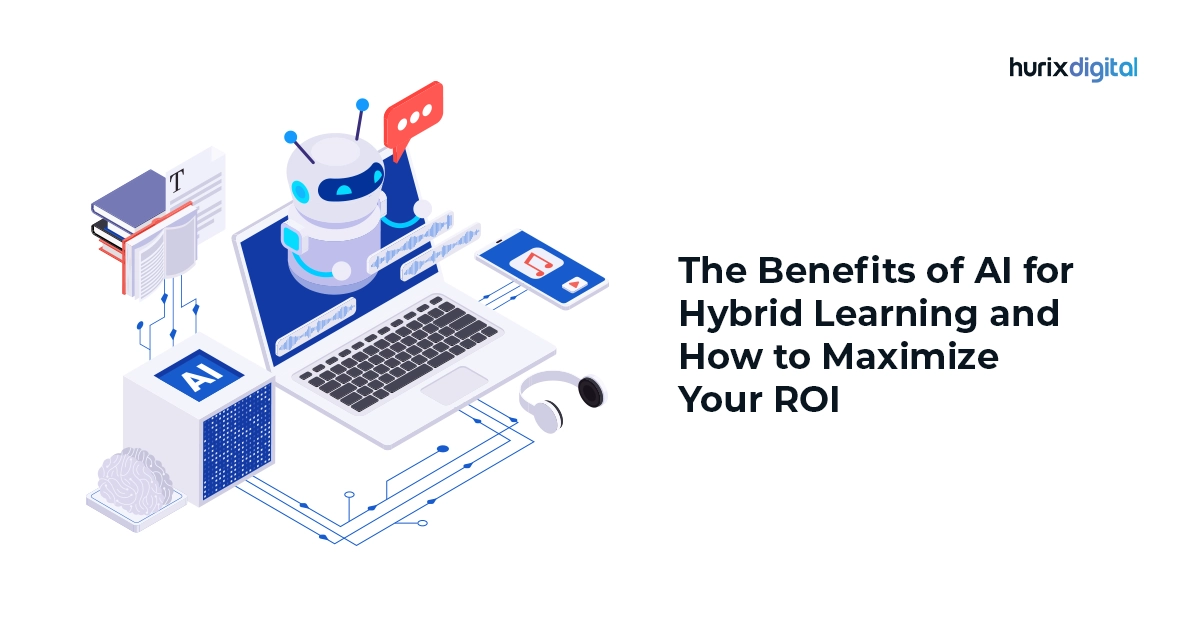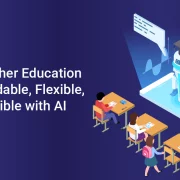
The Benefits of AI for Hybrid Learning and How to Maximize Your ROI
Summary
Explore the benefits of integrating AI into hybrid learning environments and learn how to maximize return on investment through effective AI applications.
Hybrid learning, which combines online and face-to-face instruction, has become a popular and necessary mode of education in the wake of the pandemic. 9 in 10 educators are open to trying a hybrid learning approach with the right tools and resources.
However, hybrid learning also poses many challenges for educators and learners, such as ensuring quality, engagement, personalization, and assessment across different modalities and contexts.
Artificial intelligence(AI) can offer powerful solutions to these challenges by enabling adaptive, interactive, and data-driven learning experiences that cater to the diverse needs and preferences of learners. AI can also help educators save time, reduce costs, and improve efficiency and effectiveness in hybrid learning environments.
In this blog, we will explore how AI can be used for hybrid learning, what are the benefits and challenges of investing in AI, and how to achieve a sustainable and positive return on investment (ROI) from AI-enabled hybrid learning.
Table of Contents:
- What is Hybrid Learning?
- What is AI for Hybrid Learning?
- How to Implement AI for Hybrid Learning Effectively and Ethically?
- How To Measure and Optimize The ROI of AI For Hybrid Learning?
- Conclusion
What is Hybrid Learning?
Hybrid learning is an educational approach that combines face-to-face and online learning methods. It allows students to choose between attending classes in person or virtually, depending on their preferences and circumstances.
Hybrid learning aims to create a flexible and personalized learning experience that leverages the advantages of both traditional and digital learning modes.
What is AI for Hybrid Learning?
AI can be applied to various aspects of hybrid learning, such as:
- Content Creation and Delivery: Based on the learner’s profile, preferences, progress, and performance, AI can help design and deliver personalized, adaptive, and engaging learning content.
- Learning Analytics and Assessment: AI can assist in collecting, analyzing, and visualizing data collected from a wide range of sources, including learner interactions, behaviors, emotions, and outcomes. This offers insights and recommendations for improving learning processes and outcomes, as well as assessing and certifying the competencies and achievements of learners.
- Learning Support and Guidance: AI can also be used to provide learning support and guidance to learners and educators, such as chatbots, digital assistants, etc., who can assist in answering questions, providing feedback, suggesting resources, monitoring progress, and motivating and scaffolding learning.
- Learning Management and Administration: Learning management and administration tasks, such as scheduling, enrollment, attendance, grading, reporting, and communication, can be automated and optimized with artificial intelligence.
Also Read: How Does Realistic Simulation Enhance K-12 Learning?
How to Implement AI for Hybrid Learning Effectively and Ethically?
Investing in AI for hybrid learning is not only a matter of choosing and using the right tools and technologies but also a matter of designing and implementing effective and ethical AI-enabled education solutions.
Some of the key considerations and steps for implementing AI for hybrid learning are:
1. Define the Goals and Outcomes of Hybrid Learning
Before investing in AI in K12 education or any other learning environment, it is important to define the goals and outcomes of hybrid learning. This includes what are the learning objectives, standards, and expectations and how they will be measured and evaluated.
This will help align the AI solutions with the hybrid learning goals and outcomes and ensure that they are relevant, meaningful, and valuable.
2. Select and Evaluate the AI Solutions
It is important to evaluate and select AI solutions that will best support and enhance hybrid learning based on its goals and outcomes.
There are several factors to consider when comparing and contrasting different AI solutions, including features, functions, costs, benefits, risks, and evidence. It will help you decide which AI solutions are most suitable, effective, and reliable for hybrid learning.
3. Design and Develop AI-Enabled Learning Solutions
The AI-enabled learning solutions selected must be designed and developed so that they can be integrated and applied in hybrid learning environments.
Various aspects, including content, pedagogy, technology, and assessment, must be taken into account, and they must be aligned, coherent, and consistent throughout the AI-enabled learning process. The results will be optimal, engaging, and impactful AI-enabled hybrid learning solutions.
4. Implement and Monitor the AI-Enabled Learning Solutions
This involves considering various factors, such as the readiness, availability, accessibility, and usability of the AI-enabled learning solutions and the feedback, satisfaction, and performance of the learners and educators.
This will help ensure the smooth, effective, and ethical implementation and monitoring of the AI-enabled learning solutions for hybrid learning.
5. Evaluate and Optimize the AI-enabled learning Solutions
To evaluate and optimize the AI-enabled learning solutions, various indicators are taken into account, such as the outcomes, impacts, and challenges of the AI-enabled learning solutions and their strengths, weaknesses, opportunities, and threats.
It will help identify areas for improvement and innovation, as well as evaluate the value, effectiveness, and efficiency of these AI-enabled learning solutions for hybrid learning.
How to Measure and Optimize the ROI of AI for Hybrid Learning?
Investing in AI for hybrid learning is not only a matter of implementing and evaluating AI-enabled learning solutions but also a matter of measuring and optimizing the return on investment (ROI) of AI for hybrid learning. Hybrid learning ROI is a metric that compares the benefits and costs of the investment and indicates its efficiency and profitability.
Measuring and optimizing the ROI of AI for hybrid learning involves:
- Define the benefits and costs of AI for hybrid learning: Before measuring and optimizing the ROI of AI, it is important to define the benefits and costs of AI for hybrid learning, such as the tangible and intangible benefits and costs and how they can be quantified and monetized. This will help establish the criteria and indicators for measuring and optimizing the ROI of AI for hybrid learning.
- Calculate the ROI of AI for hybrid learning: It is important to calculate the ROI of AI for hybrid learning based on the measured benefits and costs. For example, what is the ratio or percentage of the benefits and costs? This will help estimate the value, efficiency, and profitability of AI for hybrid learning and provide the metric and benchmark for measuring and optimizing the ROI of AI for hybrid learning.
- Optimize the ROI of AI for hybrid learning: Using the calculated ROI of AI, it is imperative to optimize the ROI of AI for hybrid learning, including what factors and strategies can increase the benefits and reduce the costs and how to implement and evaluate them.
- This helps improve the value, efficiency, and profitability of AI for hybrid learning and provides feedback and guidance for measuring and optimizing the ROI of AI for hybrid learning.
Also Read: How to Use AI and Gamification to Assess Student Learning?
Conclusion
AI is a powerful and promising technology that can enhance hybrid learning experiences, improve learning outcomes, and increase ROI for educators and learners.
However, investing in AI for hybrid learning is not a simple or straightforward decision. It requires careful planning, implementation, evaluation, and optimization to ensure that the benefits outweigh the costs and risks. Moreover, it requires a clear understanding of the goals, expectations, and outcomes of hybrid learning and how AI can support and enhance them.
If you are interested in investing in AI for hybrid learning and want to learn more about how to do it effectively and ethically, you can contact Hurix Digital, a leading provider of AI-enabled tech solutions.
With our expertise in AI-powered learning, intelligent tutoring systems, and AI-based assessment, we can transform your educational approach. Whether it’s K12 education or higher education, our EdTech solutions are tailored to provide an engaging and effective learning experience.
So why wait? Explore the use of AI in education with Hurix Digital today!



